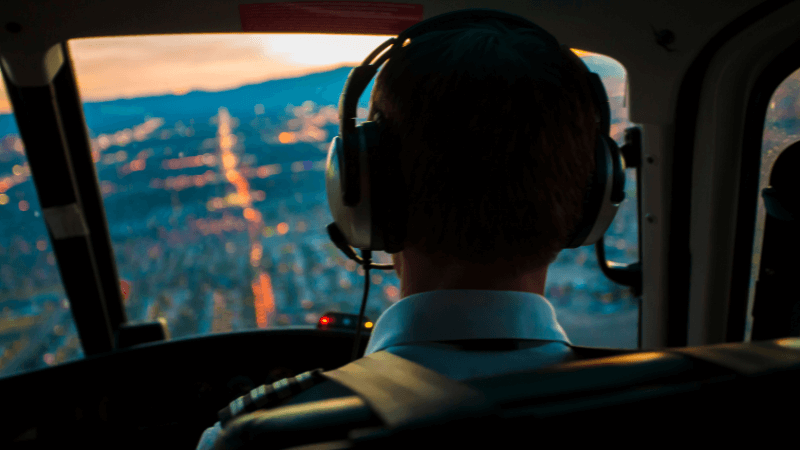
In the dynamic world of aviation, one of the key skills that separates proficient pilots from the rest is situational awareness (SA). It is the ability to perceive, comprehend, and project the current and future state of the flight environment. Achieving and maintaining situational awareness is crucial for safe and efficient flight operations. As a student pilot, your situational awareness is very limited. Only through flight training and practice can your situational awareness grow. In this blog, we'll explore how pilots can cultivate and enhance their situational awareness for a more confident and secure flying experience.
Stay Informed through Pre-flight Planning:
Before even stepping into the cockpit, a pilot's journey toward situational awareness begins with thorough pre-flight planning. This includes reviewing weather forecasts, checking NOTAMs (Notices to Airmen), studying the route, and understanding any potential hazards along the way. By being well-informed from the start, pilots set the stage for a safer and more predictable flight. For student pilots, this includes studying the maneuvers for the given lesson. Showing up prepared allows you to successfully focus on the lesson while not ignoring other influences on the flight.
Utilize Advanced Avionics and Technology:
Modern avionics and technology have revolutionized aviation, providing pilots with a wealth of information at their fingertips. From GPS navigation systems to weather radar to mobile applications, these tools can significantly enhance situational awareness. Pilots should take advantage of these resources to gather real-time data and make informed decisions during flight. One word of caution: always learn and practice with these tools on the ground before going flying. In-flight is not the time to have your head buried in an app while you try to figure out how to use it.
Continuous Monitoring of Instruments:
Maintaining a constant vigil over the aircraft's instruments is a fundamental aspect of situational awareness. Pilots must regularly cross-check altitude, airspeed, heading, and other critical parameters to ensure that the aircraft is operating within safe limits. Consistent monitoring allows for early detection of any discrepancies or deviations from the planned flight path. Developing a consistent scan is an effective way to create good habits.
Develop a Mental Picture of the Environment:
Pilots should strive to build and constantly update a mental picture of their surroundings. This includes understanding the terrain, nearby airspace, and the positions of other aircraft. By visualizing the environment mentally, pilots can anticipate changes and respond proactively to any emerging challenges. Listening to live ATC communications to build your vocabulary and understanding of aviation communication can be a helpful resource when learning. The flight training environment is busy and often overwhelming. Being prepared for each flight can help you to divert some attention away from the lesson to maintain situational awareness.
Effective Communication:
Clear and concise communication is a cornerstone of situational awareness. Pilots should maintain open and effective communication with air traffic control (ATC) and other relevant parties, including their flight instructors. This ensures that they are aware of any changes to their flight plan, potential traffic conflicts, or weather updates that may impact their journey. Regarding flight training, if your instructor is aware of the mental picture you have, they can better assess if you have the full picture or if they need to assist in filling in some gaps.
Stay Flexible and Adaptable:
Situational awareness is not a static concept; it requires constant adaptation. Pilots must be flexible and ready to adjust their plans based on evolving circumstances. This might involve rerouting to avoid adverse weather, changing altitudes, or adapting to air traffic instructions. The ability to adapt contributes significantly to overall flight safety.
Crew Resource Management (CRM):
For pilots operating in a multi-crew environment, effective communication and collaboration are critical. Crew Resource Management (CRM) emphasizes teamwork, decision-making, and communication skills among the flight crew. By working together seamlessly, pilots can enhance their collective situational awareness and make well-informed decisions. Remember, even as a student pilot, you are part of the flight crew. Practicing good CRM skills early will help you to become an effective leader and team player resulting in improved flight safety.
The Big Picture:
Situational awareness is the bedrock of safe and successful flying. By integrating pre-flight planning, leveraging advanced technology, monitoring instruments vigilantly, developing a mental picture of the environment, engaging in effective communication, staying flexible, and embracing CRM principles, pilots can significantly enhance their situational awareness. As aviation continues to evolve, the importance of this skill becomes even more pronounced, ensuring that pilots navigate the skies with confidence and precision.
Begin the exciting adventure of earning your wings today! Getting a pilot's license will teach you far more than just how to fly an airplane. Contact us today to learn more about how you can get started.
FAQ's
It sounds like a difficult process to become a pilot. Truth is, it's fairly straight forward and you are guided every step of the way. Refer to the following links to learn about the process to become a pilot and the various licenses and ratings. Included in the links is our articles page which is always updated with new content that can answer more of your questions.
To answer this we need to know what kind of pilot do you want to be. Do you want to be a private pilot and fly recreationally? Or do you want to be a commercial pilot and fly for hire? One thing to note is that flight training can be a variable cost that is dependent on each specific person's rate of progress. Be wary of anyone that will give you a solid low price figure as it may be based on an absolute best-case scenario and not average statistics. Check out the link below and click on each license and rating to learn more about the specific costs and requirements. Each one is listed in the typical order in which you might obtain them.
Generally speaking, a pilot will spend anywhere from approximately $12,000 to $100,000 to become a pilot depending on what kind of pilot they want to be. Note that ground school is the cheapest part of the flight training experience. The actual flying part of the training is where the big money is spent. Flight schools roughly charge an average of $200/hr for each flight.
To hold a Private Pilot License you need to be 17 years old.
To hold a Commercial Pilot License you need to be 18 years old.
To hold an Airline Transport License you need to be 21 years old.
Level Flight Alumni Say
The number of Level Flight Ground School Pilots continues to grow. We are proud that our comprehensive and innovative Ground School curriculum inspires students to complete their first steps and continue to develop to achieve their aviation dreams. Here is what some of our students past and present say about their experience with Level Flight Ground School.
Take Flight Now
Level Flight is Canada’s best online ground school. It is our mandate to provide higher quality, more engaging training for Canadian Student Pilots. If you are seeking the exhilarating freedom of flight for a hobby or with aspirations of a career in the skies, Level Flight offers the best ground school experience available. Sign up for our online learning platform now and discover the adventure that awaits you at Level Flight.
By submitting this form, you opt-in and give expressed consent to receiving SMS / text messages, calls, and emails from us for the purposes of communication related to your inquiry or related to the products and or services we provide.
